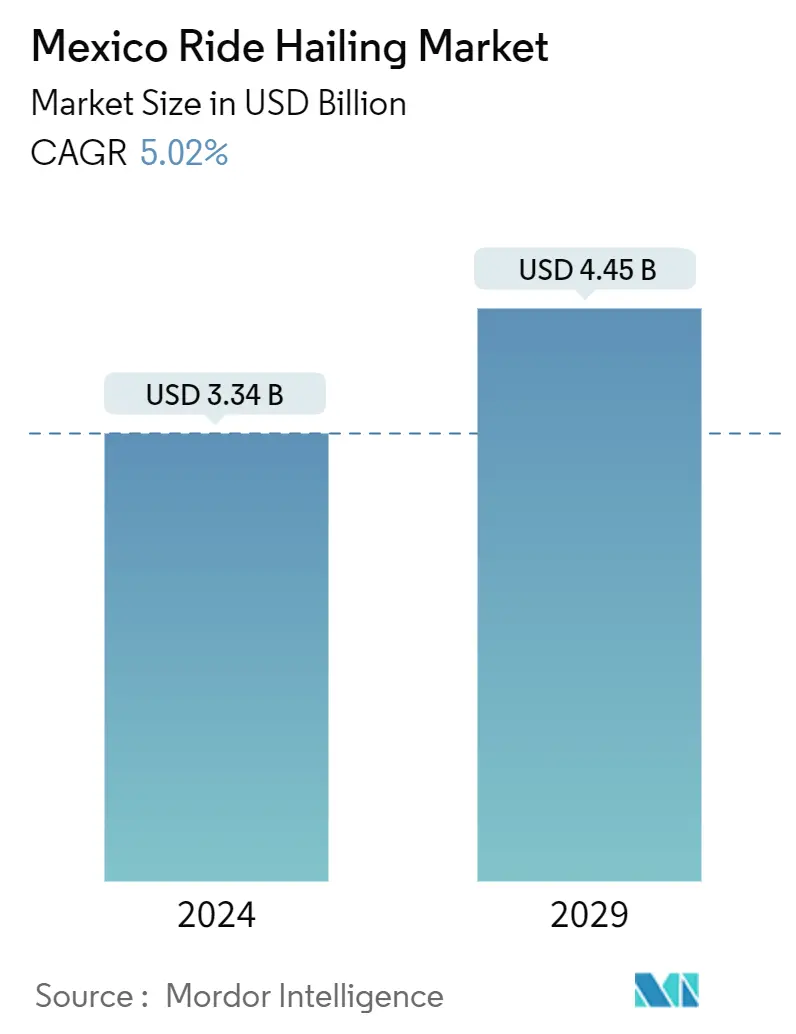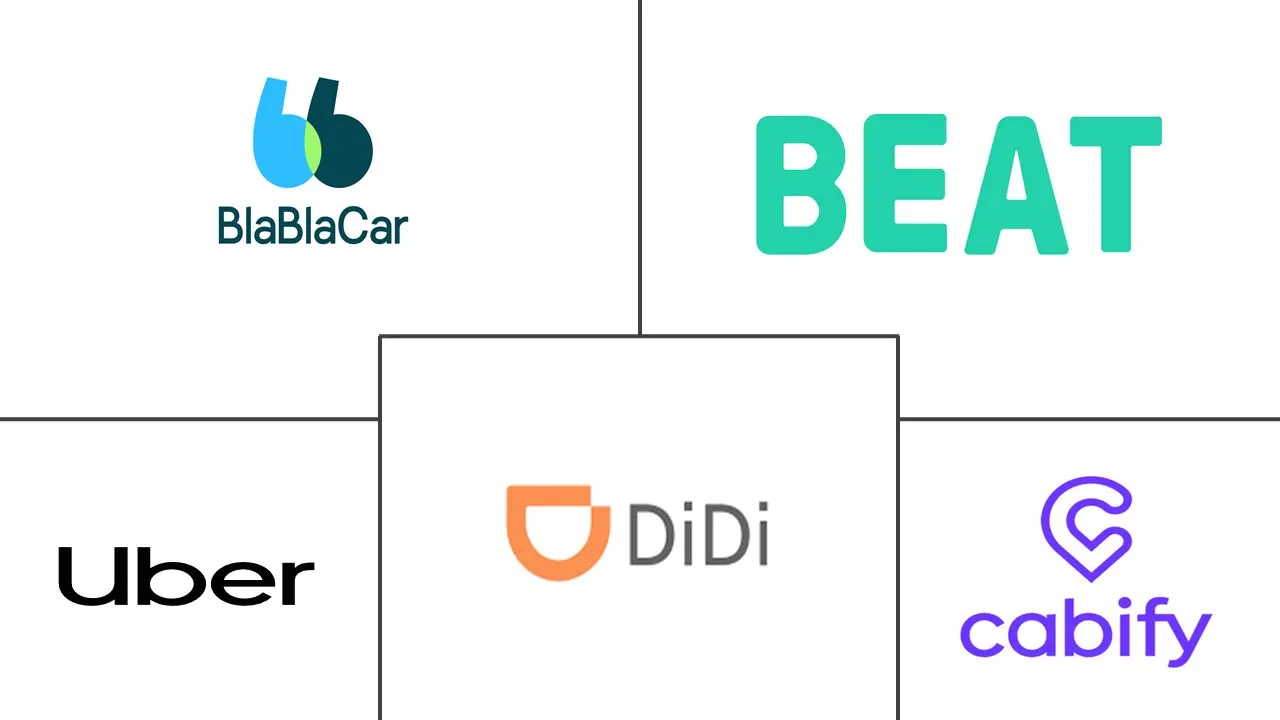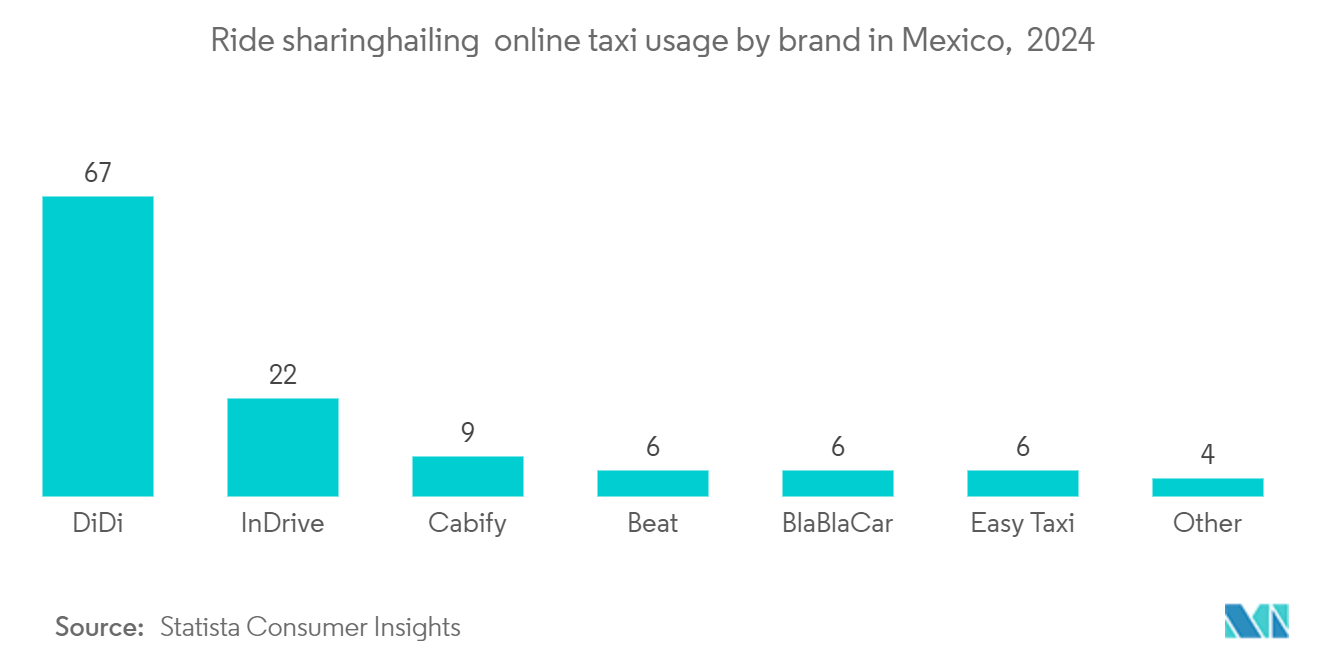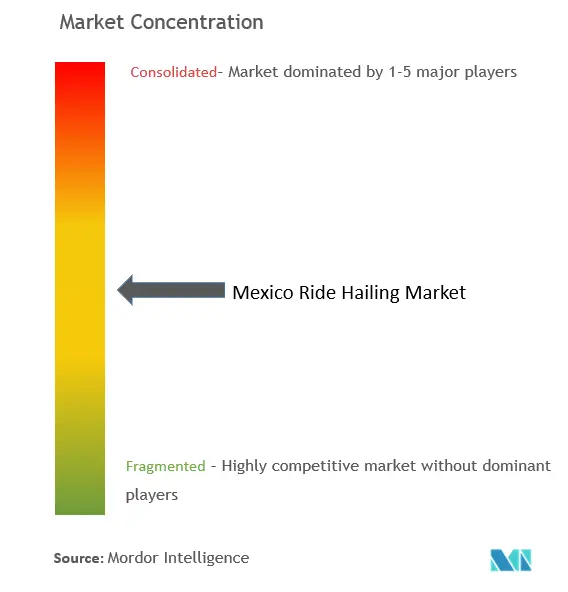Mexico Ride Hailing Market Size

| Study Period | 2019 - 2029 |
| Base Year For Estimation | 2023 |
| Market Size (2024) | USD 3.34 Billion |
| Market Size (2029) | USD 4.45 Billion |
| CAGR (2024 - 2029) | 5.02 % |
| Market Concentration | Medium |
Major Players
*Disclaimer: Major Players sorted in no particular order |
Mexico Ride Hailing Market Analysis
The Mexico Ride Hailing Market size is estimated at USD 3.34 billion in 2024, and is expected to reach USD 4.45 billion by 2029, growing at a CAGR of 5.02% during the forecast period (2024-2029).
The Mexican ridesharing market is being driven by factors such as urbanization, traffic congestion, and the increasing adoption of digital technologies.
Mexico City is a significant hub for ridesharing services due to its large population and high demand for convenient transportation options. However, ridesharing services are also prevalent in other major cities like Guadalajara, Monterrey, and Puebla.
The market is dominated by global players such as Uber and DiDi and local companies like Cabify and Beat. Uber entered the Mexican market in 2013 and has since expanded its operations to over 60 cities across the country.
The COVID-19 pandemic had a significant impact on the ridesharing market in Mexico, with a decline in demand due to lockdowns and travel restrictions. However, the market has shown signs of recovery, with companies implementing strict safety measures and hygiene protocols to regain consumer confidence. For instance, in June 2020, Uber announced a series of safety measures, including mandatory face coverings for riders and drivers and regular cleaning of vehicles.
The Mexican government has also taken steps to regulate the ridesharing market, aiming to ensure fair competition, consumer protection, and tax compliance. In 2019, the Mexican Senate approved a law that established regulations for ridesharing services, requiring companies to obtain operating licenses and comply with various safety and labor standards.
Despite all the challenges posed by the pandemic and regulatory changes, the Mexican ridesharing market is expected to continue its growth fueled by the increasing urban population, the convenience and affordability of ridesharing services, and the increasing adoption of digital technologies among consumers.
Mexico Ride Hailing Market Trends
Online Booking Channel is Expected to be the Dominant Booking Mode
Reduced taxi fares and ease of booking through mobile apps are the major factors driving online taxi booking to capture a significant share in the region. With the advent of e-hailing taxi applications, such as Uber, ridesharing has been one of the game-changing innovations in the transportation sector.
In addition, the increasing adoption of smartphones embedded with GPS, linked with the availability of digital road maps through APIs, offered essential supporting facilities such as navigation and tracking for ridesharing services.
In 2023, over 71% of Mexicans (60 million) used the internet, providing access to ridesharing apps like Uber and Didi Chuxing. Over 85% of Mexicans owned smartphones, the essential tool for booking rides, navigating routes, and managing payments.
Additionally, ridesharing apps offer a convenient and often affordable alternative to traditional taxis, especially in areas with limited public transportation. Moreover, companies operating in this market offer consumer-centric mobile platforms and various vehicle options to cater to a larger customer base.
Hence, the online booking system is expected to dominate the Mexican ridesharing market during the forecast period.

The Intracity Segment is the Most Used Distance Type Segment
The intracity segment is the most used distance type segment of the Mexican ridesharing market, driven by growing urbanization, traffic congestion, and the need for convenient and affordable transportation solutions in major cities. The intracity segment accounted for over 70.7% of the Mexican ridesharing market in 2022.
Further, the dominance of the intracity segment in the Mexican ridesharing market can be attributed to the country's rapid urbanization and the challenges associated with urban mobility. According to data from the World Bank, Mexico's urban population grew from 71.3% in 2000 to 80.5% in 2021. This increasing urbanization has led to higher traffic congestion, longer commute times, and an increasing demand for convenient and cost-effective transportation options within cities.
In addition, the COVID-19 pandemic contributed to the growth of the intracity ridesharing segment in Mexico. As people sought to avoid public transportation due to health concerns, ridesharing services became a popular alternative for shorter trips within cities.
While the intracity segment dominates the Mexican ridesharing market, other distance types, such as intercity and airport transfers, are also gaining traction. However, the intracity segment remains the most significant due to the convenience, affordability, and increasing demand for urban mobility solutions in Mexico's rapidly urbanizing cities.

Mexico Ride Hailing Industry Overview
The Mexican ridesharing market is dominated by ridesharing giants, such as Uber and Lyft, accounting for the majority of the market share. Agreements between corporations and ridesharing companies to reduce traffic congestion and control pollution from vehicle emissions have been major driving factors of the market in this region.
• April 2022: Vemo, a Mexican company, ordered 1,000 electric vehicles from BYD to expand its EV taxi fleet. BYD D1 was unveiled in 2020 as an electric minivan exclusively designed for ridesharing. According to BYD, the Mexican fleet of D1s will be the largest EV taxi fleet outside China.
Mexico Ride Hailing Market Leaders
-
Uber Technologies Inc.
-
BEAT
-
BlaBlaCar
-
Cabify Spain SLU
-
Didi Chuxing Technology Co.
*Disclaimer: Major Players sorted in no particular order

Mexico Ride Hailing Market News
- February 2024: To provide financial assistance, inDrive, a ridesharing platform, collaborated with the financial technology firm R2 to offer loans and credit cards to its drivers in Mexico. To facilitate this, inDrive collaborated with Mastercard and other local fintechs like Giro and Galileo.
- July 2023: Hoop Carpool, the shared mobility startup, raised USD 1.3 million in investment funds in a round led by Ship2B Ventures through BSocial Impact Fund, with additional support from Banco Sabadell, FEI, AXIS, and 4Founders Capital.
- June 2022: International Finance Corporation (IFC) invested USD 15 million in BlaBlaCar to support the shared-travel platform's growth in Mexico and Brazil.
Mexico Ride Hailing Market Report - Table of Contents
1. INTRODUCTION
- 1.1 Study Assumptions
- 1.2 Scope of the Study
2. RESEARCH METHODOLOGY
3. EXECUTIVE SUMMARY
4. MARKET DYNAMICS
-
4.1 Market Drivers
- 4.1.1 Increase in Internet and Smartphone Penetration is Driving the Market
-
4.2 Market Restraints
- 4.2.1 Stringent Transport Policies by the Government are a Challenge
-
4.3 Industry Attractiveness - Porter's Five Forces Analysis
- 4.3.1 Threat of New Entrants
- 4.3.2 Bargaining Power of Buyers/Consumers
- 4.3.3 Bargaining Power of Suppliers
- 4.3.4 Threat of Substitute Products
- 4.3.5 Intensity of Competitive Rivalry
5. MARKET SEGMENTATION (Market size by Value - USD Billion)
-
5.1 By Service Type
- 5.1.1 E-hailing
- 5.1.2 Car Sharing
- 5.1.3 Car Rental
- 5.1.4 Other Service Types
-
5.2 By Type
- 5.2.1 Peer-to-peer Sharing
- 5.2.2 Business Sharing
-
5.3 By Booking Channel
- 5.3.1 Online
- 5.3.2 Offline
-
5.4 By Vehicle Type
- 5.4.1 Two Wheelers
- 5.4.2 Passenger Cars
-
5.5 By Distance
- 5.5.1 Intercity
- 5.5.2 Intracity
6. COMPETITIVE LANDSCAPE
- 6.1 Vendor Market Share
-
6.2 Company Profiles*
- 6.2.1 Uber Technologies Inc.
- 6.2.2 Didi Chuxing Technology Co.
- 6.2.3 Cabify Spain SLU
- 6.2.4 BEAT
- 6.2.5 BlaBlaCar
- 6.2.6 Lyft Inc.
- 6.2.7 Ola Cabs
- 6.2.8 Wingz Inc.
7. MARKET OPPORTUNITIES AND FUTURE TRENDS
- 7.1 The Market is Expected to Witness the Emergence of Autonomous Ridesharing Services
Mexico Ride Hailing Industry Segmentation
Ridesharing is when riders hire a personal driver to take them to a destination. The service is operated online, and consumers book their rides through an online mobile application.
The Mexican ridesharing market is segmented by service type, type, booking channel, vehicle type, and distance. By service type, the market is segmented into e-hailing, car sharing, car rental, and other service types. By type, the market is segmented into peer-to-peer sharing and business sharing. By booking channel, the market is segmented into online and offline. By vehicle type, the market is segmented into two-wheelers and passenger cars. By distance, the market is segmented into intercity and intracity. The report offers market size and forecasts for all the above segments in terms of value (USD).
| By Service Type | E-hailing |
| Car Sharing | |
| Car Rental | |
| Other Service Types | |
| By Type | Peer-to-peer Sharing |
| Business Sharing | |
| By Booking Channel | Online |
| Offline | |
| By Vehicle Type | Two Wheelers |
| Passenger Cars | |
| By Distance | Intercity |
| Intracity |
Mexico Ride Hailing Market Research FAQs
How big is the Mexico Ride Hailing Market?
The Mexico Ride Hailing Market size is expected to reach USD 3.34 billion in 2024 and grow at a CAGR of 5.02% to reach USD 4.45 billion by 2029.
What is the current Mexico Ride Hailing Market size?
In 2024, the Mexico Ride Hailing Market size is expected to reach USD 3.34 billion.
Who are the key players in Mexico Ride Hailing Market?
Uber Technologies Inc., BEAT , BlaBlaCar, Cabify Spain SLU and Didi Chuxing Technology Co. are the major companies operating in the Mexico Ride Hailing Market.
What years does this Mexico Ride Hailing Market cover, and what was the market size in 2023?
In 2023, the Mexico Ride Hailing Market size was estimated at USD 3.17 billion. The report covers the Mexico Ride Hailing Market historical market size for years: 2019, 2020, 2021, 2022 and 2023. The report also forecasts the Mexico Ride Hailing Market size for years: 2024, 2025, 2026, 2027, 2028 and 2029.
Mexico Ride Hailing Industry Report
Statistics for the 2024 Mexico Ride Hailing market share, size and revenue growth rate, created by Mordor Intelligence™ Industry Reports. Mexico Ride Hailing analysis includes a market forecast outlook to 2029 and historical overview. Get a sample of this industry analysis as a free report PDF download.



